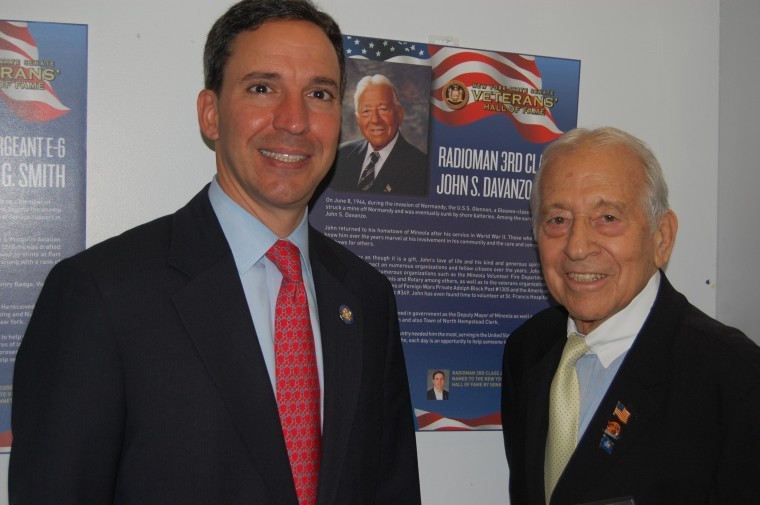In the early morning of June 8, 1944, the destroyer U.S.S. Glennon was firing at shore batteries in support of the D-Day invasion when it struck a mine and eventually sank.
A young radioman named John DaVanzo was one of the last to abandon ship, but not before he destroyed the ship’s radio equipment and codes.
DaVanzo, who now lives in Mineola, was recognized on June 14 for his service in the military by being inducted into the New York State Senate Hall of Fame, which recognizes outstanding veterans from the state who have distinguished themselves both in military and civilian life.
“For this year’s honor, I nominated Mr. DaVanzo,” said state Sen. Jack Martins. “He is a survivor of D-Day and has been a tremendous statesman for our community.”
Each state senator can nominate someone from his or her district annually. Martins said there were many worthy candidates in the 7th Senate District, but few matched DaVanzo’s service during the war and after.
A long life in civil service followed DaVanzo’s service in the navy during World War II. He has served as deputy mayor in Mineola, as well as Town of North Hempstead councilman and clerk.
DaVanzo has also been an active volunteer in the Mineola Fire Department, and a member of the local Knights of Columbus, Kiwanis, and Rotary.
A member of both VFW Private Adolph Block Post 1305 and American Legion Post 349, DaVanzo is also an usher at Corpus Christi Church.
These days, DaVanzo regularly mans a post at the entrance of Mineola Village Hall, directing residents to the right office, and he also puts in time as a volunteer at St. Francis Hospital.
DaVanzo said he was particularly pleased to receive personal congratulations from state senators Dean Skelos (R-Rockville Centre), Charles Fuschillo (R-Merrick) and Carl Marcellino (R- Oyster Bay), all of whom he knows as an active member of the Republican Party.
“That was an exciting moment. It’s quite an honor to have them come up,” he said.
DaVanzo said receiving the recognition in the company of other veterans was “very humbling.”
On that distant June morning in 1944, DaVanzo did his job as the German Army’s shore batteries fired on the ship lurching 2,000 yards from the D-Day beachhead.
“They could see that we were damaged and they were firing at us,” DaVanzo said, recalling the shells he saw splashing in the sea around the sinking ship.
It was in sharp contrast to the brilliant flashes from the antiaircraft guns on the Glennon and other ships, which had fired the day before at German planes dropping mines in the sea.
Asked what he was thinking as he carried out his mission to destroy the radio hardware and codes, DeVanzo said he doesn’t recall thinking about anything except the urgent task at hand.
“I just kept destroying things,” DaVanzo recounted.
DaVanzo was just coming on duty for the 8 a.m. shift on the ship’s bridge when the mine hit his ship’s stern. Otherwise, he might have been one of the destroyer’s 25 crew members who perished.
DaVanzo was shipped to Scotland, given a month of survivor leave, and shipped back to New York on the Queen Mary.
Back in Mineola, he married his fiance, Pauline, the month after his ship sunk. He then served on a “sub chaser” patrolling the Florida coast and then did shore duty there for the remainder of the war.
Even without the call to be honored in Albany, DaVanzo finds himself reflecting on the fate of those shipmates on the Glennon who didn’t survive at this time of year, and the reason for his survival.
“I blame it all on God,” he said.



